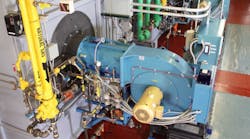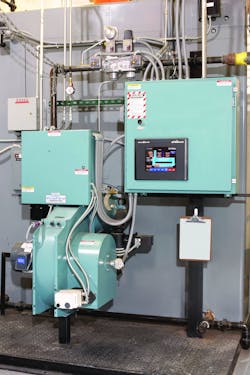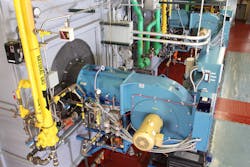Typically, after 10 to 15 years of service, a burner loses effectiveness and sees its efficiency plummet. Replacing a legacy burner with a new one that has a higher turndown capability and advanced controls can yield numerous benefits, including fuel savings, reduced emissions, improved reliability, and increased safety.
Hospital Retrofit
In Milwaukee, a 1-million-sq-ft hospital had three 1960 21,000-lb-per-hour (600 hp) boilers operating at 100 psig, providing steam for building heat, humidification, sterilization, and some cafeteria functions. The boilers fired gas and No. 2 oil, using steam atomization to vaporize the oil. During winter, the hospital operated a newer 1,200-hp high-pressure watertube boiler and allocated one of the 1960 boilers to hot standby mode for emergencies.
A few years ago, facility engineers considered replacing the boilers with new, more efficient units to save money on fuel. After exploring the cost of replacement, they asked the facility’s new boiler-room chief for his opinion. The chief inspected the boilers and found them to be sound for their age and worthy of an investment to improve reliability and reduce energy costs.
The boiler chief’s recommendation was to replace the burner-management system (BMS) and combustion-control system (CCS). The existing basic loop controllers were outdated, and securing parts had become difficult.
The hospital’s executive team approved the retrofitting of the three 1960 boilers with new BMS and CCS; however, the new chief had not been made aware of several other severe problems, such as rough light-offs, that had been occurring periodically.
Once apprised, the new chief noticed combustion was running extremely rich and the burner was not atomizing oil properly upon a switch to the alternate fuel, No. 2 oil. Additionally, the nozzle was not being purged sufficiently before a re-light after shutdown. Oil was pooling in the throat area of the furnace. One day, there was another rough light-off quickly followed by a furnace occurrence.
The hospital immediately contacted Menomonee Falls, Wis.-based boiler service company PBBS Equipment Corp. PBBS confirmed poor steam atomization caused the furnace occurrence. The hospital then asked PBBS for a quote to update the system.
PBBS evaluated how well the existing burner was tracking the load during the day, cycling patterns, furnace dimensions, flame length/width limitations, draft, boiler-room clearances, installation requirements, and more. PBBS prepared a formal proposal that was reviewed by the hospital’s operational team and then approved by the hospital’s executive management.
The hospital elected to retrofit two of the 1960 boilers with new forced-draft burners. The retrofit of the third boiler was delayed until additional funding was made available.
PBBS began by engineering and rebuilding the boiler front walls. As work progressed, an inspection of the stack dampers revealed a defect: One of the dampers was not closing properly, allowing a constant stream of air to be pulled through the offline boiler. This problem was solved by welding metal strips on both ends of the damper blade.
The front-wall casing was modified and reinforced to accommodate the new 10:1-turndown burners. When the burners and controls arrived on site, the materials were conveyed into the building through a large overhead door and then through a series of hallways leading to the boiler room.
The electrical circuitry was designed to interface with the new BMS and CCS, which included parallel positioning, automatic draft control, modulating feedwater control, and a variable-frequency drive on the combustion-air fan motor.
PBBS engineered a tie-in to the building-automation system to provide the monitoring capability desired by the hospital’s facility staff.
The eight-day installation beat the time requirement set during the planning stages. Additionally, the burners have exceeded performance expectations, increasing fuel efficiency by 5 to 7 percent while providing peace of mind regarding safety.
High-Rise Retrofit
Another burner-retrofit project took place at St. Paul’s Towers, a 23-story senior-living community in Oakland, Calif.
When the building was constructed, two watertube boilers with natural-gas inputs of 6 million Btuh were installed. The boilers were constructed with flexible serpentine tubes swedged into upper and lower headers, providing multiple gas passes.
The hot-water boilers provide heat for the building and serve as the heating medium for a separate water-to-water heat exchanger that supplies water to sinks, tubs, and showers.
The burners were in excellent working order, but unable to meet newly enforced California emission regulations requiring nitrogen-oxide (NOx) levels of 15 ppm or less. The burners were generating over 100 ppm because the law did not include NOx limitations for boilers of this size at the time of installation. The only choices were to retrofit the boilers with flue-gas recirculation (FGR) or replace the burners with low-NOx equivalents.
Facility management contacted Hayward, Calif.-based R.F. MacDonald Co. for its opinion and recommendation.
Cost—initial and ongoing operational—was a major concern of the owner. There also was the issue of gas pressure. The gas pressure at the meter was low (less than 1 psig) and could not be increased. Adding a gas booster to the upgrade package was cost-prohibitive. This was important, as employing FGR would have elevated electrical consumption compared with a new burner. Even more importantly, FGR would have increased the building’s gas-pressure requirement.
A new low-NOx burner without FGR that was able to operate on lower gas pressures appeared to be the best solution, meeting all requirements, including NOx performance, high efficiency, ease of retrofit, and good quality.
R.F. MacDonald reviewed furnace dimensions to determine flame volume, length, and width to negate the possibility of flame impingement on the walls of the furnace, which would have caused combustion rumbling, sooting, and carbon-monoxide formation.
The engineer stressed the importance of proper burner selection. Not only did the burner have to fit the boiler dimensions and required clearances, the flame envelope had to be compatible with the furnace, especially as it related to draft and furnace-pressure variations.
R.F. MacDonald decided on a low-NOx surface combustion burner that pre-mixes fuel and air, does not require the use of FGR, and is cost-effective.
Before the final purchase order was issued, R.F. MacDonald had to confirm how the new burners were going to get to the boiler room, which was on the roof. This meant the boilers either had to be crane-lifted to the roof from the outside, which was costly, or brought up on the elevator.
To minimize cost, the burners were conveyed using the elevator. The major components of the burner were shipped separately and re-assembled in the mechanical room.
Once the burners were re-assembled into complete packages, they were installed on the boilers using a chain hoist. The supporting platforms were fabricated and placed in position before the burners were bolted on to the newly fabricated burner doors. The control panels then were mounted in front of the burner assembly for easy access.
Installation took less than a week because of good planning and execution.
The burners met all of the customer’s requirements. They achieved NOx levels below 15 ppm, higher burner turndown (from 3:1 to 5:1), superior hot-water-system control, and fuel savings of approximately 30 percent on a $38,000-per-month bill.
Matching Burner to Boiler
For a burner retrofit to be executed properly, flame shape and length, or flame envelope, must be matched to the furnace or combustion chamber. This ensures high heat transfer without impingement on the furnace walls in a manner detrimental to the furnace or convection-pass materials.
Another key consideration when doing a burner retrofit is combustion noise or combustion vibration, often referred to as “combustion rumble.” Every boiler assembly has its own resonant frequency, so it is important to ensure a burner’s combustion characteristics integrate well with a boiler acoustically.
Burners typically are not custom-designed. Therefore, their design must be flexible enough so that, during the commissioning process, any undesirable combustion noise can be “tuned out” for smooth operation throughout the firing range.
A burner should be constructed of castings or heavy-gage materials and “spinnings” that afford strength to burner surfaces, reducing unwanted high-frequency vibrations. Otherwise, at certain loads, the whole package may vibrate, causing unacceptable noise and undue wear and tear on the system.
While burners constructed of light-gage sheet metals and with large flimsy surfaces may be less expensive up front, they are noisier to operate and have a much shorter life expectancy. Over time, they generally become more expensive to the owner.
Ensure a new burner will be easy to inspect and maintain on a regular basis. An operator should not have to pull a burner off of a vessel or, worse, crawl through a furnace to get to a burner, particularly larger ones.
It is important to remember that, even with a state-of-the-art burner, regular maintenance is necessary to ensure optimal fuel-air ratio throughout a boiler’s firing range and service life. Proper and consistent service will maintain boiler efficiency and keep fuel expenditures in check for years to come.
An expert in steam and hot-water generation, Steve Connor recently retired as director of technical and marketing services for Cleaver-Brooks. David Lucas is sales manager for the Cleaver-Brooks ProFire line of burner products.











